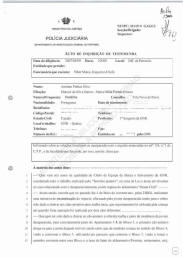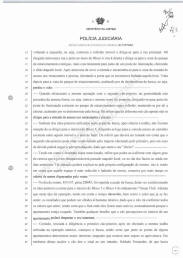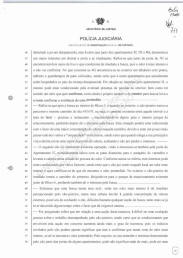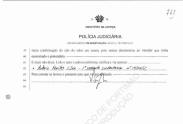|
762 to 765 Witness statement of Antonio
Freitas Silva 2007.05.09 |
|
TRANSLATION BY INES |
|
03 Processos, volume III
Pages 762 to 765 |
|
03_VOLUMEIIIa_Page_762 |
 |
|
03_VOLUMEIIIa_Page_763 |
 |
|
03_VOLUMEIIIa_Page_764 |
 |
|
03_VOLUMEIIIa_Page_765 |
 |
Witness Statement of Antonio
Freitas Silva
Date: 2007.05.09
Location: DIC Portimao
Occupation: 1st Sergeant GNR
Location: GNR-Queluz
The deponent states that:
- He comes to the process in
the role of Chief of the GNR
Search and Rescue Team. He
coordinated all the work
carried out by the two
sniffer dogs in the Luz zone
and the immediate areas
relating to the
disappearance of the English
minor Madeleine McCann from
the Ocean Club.
- He remembers that on the
4th of May of the current
year, around 23H00, they
attempted to tentatively
identify and thus
reconstruct the path taken
by the missing minor. They
gave the dogs a Turkish bath
towel which was supposedly
used by the child in
question. This operation was
realised by two different
dogs.
- That after having smelt
the aforementioned towel,
next to the residence of the
missing girl, more
specifically next to block
5’s apartment 5A, the first
tracker-dog headed toward
the door of that apartment,
soon whirled about in the
direction of block 4,
bypassing block 5 along a
route (the corridor) that
goes around that block and
gives unto a path that runs
between this block and the
resort’s leisure area
(pools, restaurants, etc).
The dog went into the path
on the left, heading toward
the main road (Francisco
Gentil Martins). Once there,
he crossed the street and
close to block 6’s wall,
turned right, heading toward
the contiguous parking area,
more particularly toward a
light post where he sniffed
the ground. After this, he
crossed the street again and
headed toward the resort’s
access zone, sniffing the
door which was closed at
that time. He again went to
the parking zone, but
finally lost interest in the
search, i.e lost the scent.
- When carrying out this
operation with the second
dog, he followed the same
rout, took the same
direction and headed toward
the light post in the
parking lot mentioned above.
He sniffed the area and at
that point appeared to have
lost the scent. The only
difference was that this dog
did not head toward the
entrance of the restaurant
or the pool area.
- None of the dogs used in
this search, after having
been given the towel
supposedly used by the
child, entered into block 5
but went immediately to the
street between the apartment
and the leisure area. It
should be taken into account
that the second sniffer dog
may have been conditioned by
the first sniffer dog. That
is to say that in the case
of doubt, the second dog may
have followed the second of
the first.
- Taking into account the
aforementioned results, he
states that it can be
confirmed with a certain
degree of certainty that the
missing child passed by that
location, on that day or on
a previous day. This
situation can be explained
by the nature of the
terrain, that is, it is a
small space enclosed by
walls and as such lingering
scents would take longer to
dissipate.
- Yesterday (08.05.2007)
around 23H45, this search
action was repeated but this
time the dogs were sent into
blocks 5 and 4 of the ‘Ocean
Club’ resort. During this
operation, and given the
time that had passed
combined with the heat, the
results that were achieved
are very relative given that
the dog will confirm all the
odours it scents, certainly
alerting to those that are
most active, namely due to
the fact that the apartment
was occupied. It is also
noted that the dog’s
perception in the interior
may be affected by noise.
- The initial diligence
carried out with first
sniffer dog, after having
sniffed the towel used in
the previous operation,
began searching and showing
interest in some doors
leading to other apartments.
He did not show any interest
or even approach other
apartments. In none of these
actions did the dog give the
signal to his trainer,
Soldado Fernandes. It is
certain however, that the
dog signalled next to
apartments 5J, 5H, and 4G.
He showed great interest in
sniffing these doors and the
immediate areas. Next to
door 5H there were two bags
of rubbish and the odour may
have distracted the dog.
Outside 4G was a tray of
plates, cutlery and cloth
napkins that had apparently
been used. This apartment is
where the parents of the
missing child were staying
(at the time). Concerning
apartment 5J, the same may
have been conditioned by the
presence of people in the
interior or he could have
sniffed an odour that needed
to be confirmed.
- He states that after the
search inside block 5, and
whilst in the exterior, the
sniffer dog took the same
route on 04.05.07, being the
existent road of that
apartment and the leisure
area (pools and restaurant)
and then went to the same
parking area. At that point,
the scent was lost. This
situation may be related to
the fact that the biggest
concentration of odours are
in that area and due to the
fact that odours are better
preserved near walls and
away from major winds. It is
certain that upon reaching
the main road and turning
right is where the biggest
concentration of odours
exist. This is where the dog
lost interest.
- The second dog was taken
through the same operation
and also showed interest at
the door of apartment 5J.
This same dog jumped on his
hind paws to the parapet of
the veranda and raised his
head as though in search of
an odour. As related above,
this interest could have
been the result of various
factors but it is certain
that in this area the scent
was intense. In the
exterior, the sniffer dog
immediately headed to the
parking area next to block 6
and there apparently lost
the scent.
- I would like to clarify
that a search in a bad area,
where a more intense odour
perceived by the sniffer
dog, such as in an urban
area due to the large
concentration of external
odours, make it possible to
confuse the dog. In this
situation, search activity
is very difficult as is the
case when some time has
passed since the event in
question.
- Because he is asked, he
states that in relation to
this, it is difficult to
evaluate precisely the work
of the sniffer dog. It is
clear that some conditions
involved in this action
augment the degree of
uncertainty. The signalling
of the dog may only signify
that they are confirming an
intense odour in a zone. On
the other hand, given the
interest of the dog(s) in
some of the apartment
doorways, this could signify
nothing, but could also very
well mean that the dog has
caught the odour. The dog
did not demonstrate to its
owner that it had found the
scent it was searching for.
- And nothing more was said.
Reads, ratifies and signs.
|
|
|
TO HELP KEEP THIS SITE ON
LINE PLEASE CONSIDER
|
|
|
|
|